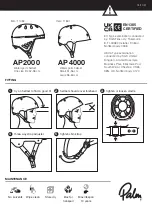
10 TUNING THE CHASSIS
38
–
Check the static sag of the shock absorber. (
–
Check the riding sag of the shock absorber. (
–
Adjust the rebound damping of the shock absorber. (
10.12
Checking the basic setting of the fork
Info
For various reasons, no exact riding sag can be determined for the fork.
401000-01
–
Smaller differences in the rider's weight can be compensated for by
the fork air pressure.
–
However, if the fork frequently bottoms out (hard end stop on com-
pression), the fork air pressure must be increased, within the speci-
fied values, to avoid damage to the fork and frame.
–
If the fork feels unusually hard after extended periods of operation,
the fork legs need to be bled.
10.13
Adjusting the fork air pressure
Warning
Danger of accident
Modifications to the suspension setting may seriously alter the handling characteristic.
Extreme modifications to the suspension setting may cause a serious deterioration in the handling characteristic
and overload components.
–
Only make adjustments within the recommended range.
–
Ride slowly to start with after making adjustments to get the feel of the new handling characteristic.
Info
Check or adjust the air pressure under the same conditions at the earliest 5 minutes after switching off the engine.
The air suspension is located in the left fork leg. The pressure and rebound damping is located in the right fork leg.
Preparatory work
–
Raise the motorcycle with a lift stand. (
S04525-10
Main work
–
Remove protection cap
1
.
–
Push together fork airpump
2
fully.
Fork airpump (79412966100)
Info
The fork airpump is included as part of the motorcycle's
accessory pack.
–
Connect the fork airpump to the left fork leg.
The fork airpump indicator switches on automatically.
A little air escapes from the fork leg when connecting.
















































